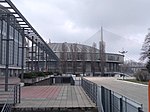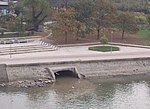FEFA
FEFA (Serbian: ФЕФА / FEFA), officially Metropolitan University - FEFA (Serbian: Универзитет Метрополитан - ФЕФА / Univerzitet Metropolitan - FEFA), formerly known as Faculty of Economics, Finance and Administration as a part of Singidunum University is a faculty in Novi Beograd, Belgrade, Serbia. It has been founded in 2001, and while de facto remaining independent, it was initially a member of Singidunum University and now is a member of the Metropolitan University. This higher education institution received its accreditation certificate in 2008, as first economics and management school in the country to do so under rules established by new Law on Higher Education, renewing these certificates in 2014 and 2017.
Excerpt from the Wikipedia article FEFA (License: CC BY-SA 3.0, Authors).FEFA
Bulevar voјvode Misica, Belgrade Београд (Савски венац) (Savski Venac Urban Municipality)
Geographical coordinates (GPS) Address Nearby Places Show on map
Geographical coordinates (GPS)
| Latitude | Longitude |
|---|---|
| N 44.794448 ° | E 20.436284 ° |
Address
Fakultet za inženjerski menadžment
Bulevar voјvode Misica 43
11000 Belgrade, Београд (Савски венац) (Savski Venac Urban Municipality)
Central Serbia, Serbia
Open on Google Maps








